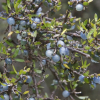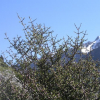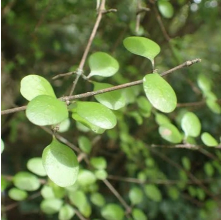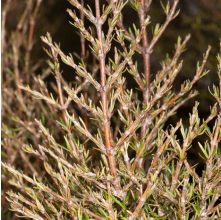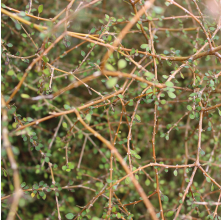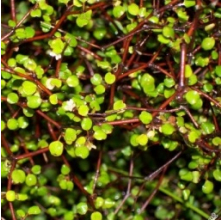Coprosma propinqua
(Mingimingi)
Coprosma propinqua
(Mingimingi)
Prices:
| Each | 20 or more | |
|---|---|---|
| 2.5L Pot | $9.50 | $9.00 |
Details:
| Type: | Shrub |
| Growth Rate: | Medium |
| Mature Height: | 3 m |
| Mature Width: | 1.5 m |
| Site Condition: | Coastal, Exposed, Frost Tolerant, Heavy Soil, Loamy Soil, Sandy Soil, Waterways |
| Sun: | Full Sun, Part Shade |
| Drainage: | Dry, Moist, Wet |
| Frosts: | Hardy |
| Features: | Drought tolerant. Suitable for hedging or shelter. Attractive to birds, insects and lizards. Rongoa. Low Flammability. Flower colour: Green. Foliage colour: Green. Fruit colour: Pale Blue. Native. Suitable restoration species. |
Coprosma propinqua, commonly known as Mingimingi, is a species of evergreen shrub or small tree that is native to New Zealand. It belongs to the family Rubiaceae and is known for its distinctive foliage and attractive appearance.
Coprosma propinqua exhibits a compact and bushy growth habit, typically reaching a height of 1 to 3 meters. The leaves are opposite, simple, and small, measuring about 1 to 3 centimeters in length. The leaves are elliptical or lanceolate in shape, with smooth margins, and are usually glossy and dark green in color. Some varieties may have variegated leaves with contrasting colors, such as yellow or cream markings.
The flowers of Coprosma propinqua are small and inconspicuous, typically greenish or yellowish in color. They are borne in clusters and are not particularly showy. The plant is dioecious, which means that male and female flowers are borne on separate plants.
The fruit of Coprosma propinqua is a fleshy drupe, typically spherical or ovoid in shape, and about 5 to 7 millimeters in diameter. The fruit initially appears green, but matures to a dark purple or black color when ripe. The fruit is often eaten by birds, which help to disperse the seeds.
Coprosma propinqua is commonly found in various habitats in New Zealand, including forests, shrublands, and coastal areas. It is known for its ability to tolerate a wide range of growing conditions, including poor soils and exposure to salt spray, making it a hardy and adaptable plant. It is also known to have medicinal properties and has been used traditionally by Maori for various purposes.
In cultivation, Coprosma propinqua is often used as an ornamental plant in gardens and landscapes due to its attractive foliage and low maintenance requirements. It can be grown as a standalone specimen plant, or used as a hedge or ground cover. It is typically propagated by seeds or cuttings, and prefers well-drained soils and a sunny to partly shaded location.
Habitat: Found in lowland forest, along forest margins and streambanks, in scrub, gravelly places and along the edges of bogs and swamps.
Flowering: Spring [October - December]
Fruiting: Autumn [January - April]
My Lists: DrainField, Wetland, Pioneer Species
Plant Calendar:
| Jan | Feb | Mar | Apr | May | Jun | Jul | Aug | Sep | Oct | Nov | Dec |
|---|---|---|---|---|---|---|---|---|---|---|---|
| FS | FS | FS | FS |
| Flowering | Fruiting | Both | |
| Key |
| Fruit | Seed | Nectar | |
| Key | F | S | N |

